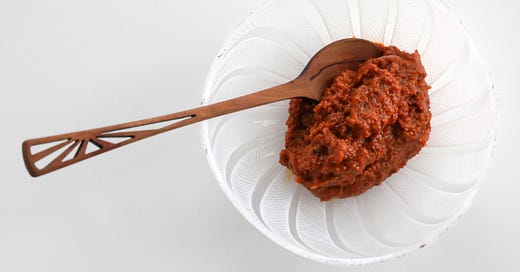If you read my veggie burger post, you may have noticed a sexy-looking dollop of something brick red in the photo. That’s what I want to talk about today, both specifically in terms of its making and generally in that it points at a universe of easily assembled and deeply delicious condiments. One of the great glories of fermenting comes when we start combining our concoctions to create new sauces that can range from amped-up versions of standards to wildly original creations.
Besides its enticing color, this orange sauce is especially appealing for its short list of ingredients: gochujang and tahini, in roughly 50/50 proportions. Gochujang brings acidity, heat, umami, and funk. Tahini contributes oil and body, and of course sesame is delicious—and not for nothing, a flavor that’s very much at home in Korean cuisine. So between the two you have a complete condiment, though of course you could add whatever else you desire, like maybe chopped scallion or cilantro or shiso, or some whole toasted sesame seeds.
Think of all the ways you can use this: bibimbap, sesame noodles, falafel, sandwiches & wraps, salads—the list is nearly infinite. And of course this concept will work with any umami post and any nut or seed butter. I’ve been a longtime fan of tahini-miso sauce, so why not doenjang and almond butter?
What remains is to get the consistency where you need it for your desired application. Do you want it thick for spreading or thin for dipping? It tends to be nice and thick (as in the photo). If you want to thin it down, you can add water and lemon juice like you would to make a tahini sauce for falafel, though because gochujang can be quite sour you might not want extra acidity. Thinking in terms of adding flavor rather than diluting it, you could use carrot juice or maybe a little roasted squash purée instead of water, or an amazake made from either carrot or squash (or something else). That sweetness, either raw or koji-amplified, might make a most welcome contribution.
You could also use oil to thin it (though at a certain point the emulsion will break and you’ll have a layer of oil floating on top of your paste). Here you’ve also got a lot of options for adding flavor. Sesame oil would double down on that note, pulling the result even farther toward Korea. Olive oil would tug it towards the Middle East. Koji oil would add a gently aromatic sweetness, and a neutral oil would just loosen up a bit. The real magic starts to happen (and your emulsion will remain intact) when you think in terms of using both oil and water to thin this out, because then you can get into the fine details that make food shine brightest.
Imagine adding both carrot-infused koji oil and carrot amazake, for example. And then using the sauce on the carrots you infused the oil with, maybe combined with some other carrots that you roasted hard… you get the idea. Simple can be just that: a two-ingredient sauce that lights up your food. Simple can also contain infinity if you zoom in closely enough, and you should. Attentively tailoring and balancing a custom condiment using components that you made yourself can persuade the craft of cooking to reveal some of its deepest secrets.




